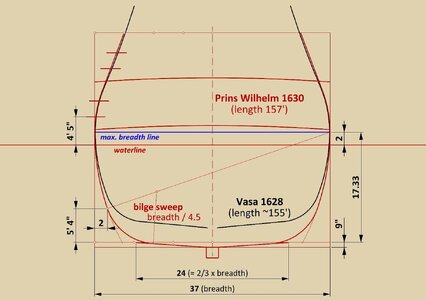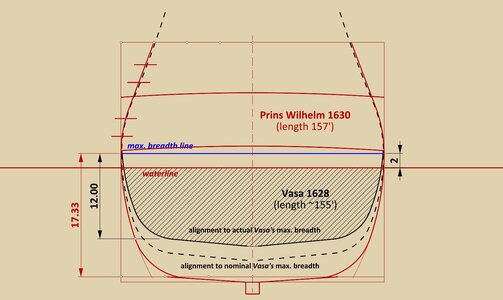Thanks Ab and Waldemar for the specific references. I think we have established that Hybertsson was clearly not following typical practice, but there is evidence that he consistently designed ships that were comparatively shallow.
First, was Hybertsson lying to the king? I appreciate that we would like not to think ill of the dead, but sacrificing his honor to save his technical reputation seems a step too far. It looks a lot like throwing out evidence that inconventiently conflicts with a theory. There is also no evidence that he lied, and it is hard to imagine the motivation for it. In Waldemar's scenario, Hybertsson was forced by external pressures (the king? economy?) to build
Vasa with timber he had already cut for a smaller ship, and then lied to the king about having timber on hand for a smaller (108 ft keel) and larger (128 ft keel) ship. Why would he do this, when what the king was asking him to do in the autumn of 1625 was to build a lengthened smaller ship? If he had only timber for the smaller class, then adapting this to a somewhat longer ship with similar scantlings should have been a better alternative than building a much bigger ship, surely? Why insist that he could not fulfill the king's command if that was the only timber he had, then build a ship substantially larger than the king requested, and that fulfilled the original design brief for the larger class, but required getting into a dispute with the king? If one is going to bow to pressure from the customer, why not go along with the easy solution (build the 120-foot ships)? I think that we are making this situation much more complicated than it was or needs to be. There is a clear timeline and relatively straightforward explanation for the result: Hybertsson designed a ship without enough depth in hold to carry its upperworks, and this design was the original intention, but deeply flawed.
A clearer demonstration of the situation can be found by comparing the dimensions and scantlings for
Tre Kronor as given in the spec Hybertsson sent to the king with the actual dimensions of
Vasa, which I have just now gone out and remeasured to be certain that no errors have crept into my notes. One could of course argue that the scantling list Hybertsson sent to the king was a complete fabrication, but I see no reason to doubt its accuracy or to conjure a motivation for Hybertsson to lie about it. There is nothing in the other documentary evidence surrounding him that suggests he was prone to lying about professional matters (he was, for example, one of the people who was called to stand surety for new citizens or others taking oaths before the municipal court, a sign of his probity and the respect with which the Stockholm community treated him).
Here is the result, along with the proposed dimensions for the king's compromise (120-foot keel).
Vasa's dimensions are converted at 1 Swedish foot (12 inches) = 297 mm, the standard Swedish foot promulgated earlier in the century, and which we can verify from the draught marks carved into the stem and stern. Where measurements are across the grain, shrinkage has been corrected (this averages 6%, based on tens of thousands of measurements taken since 1961), but even if one takes the uncorrected shrunken values, the overall picture does not change significantly:
| Item | Tre Kronor | GIIA’s proposed design | Vasa actual |
| Overall length (estimated at 1.25 * LOK) | 135 ft | 150 | 160 (actual) |
| Keel | | | |
| length | 108 ft | 120 ft | 130 ft |
| width | 21 in | 21 in | 24 in |
| depth | 21 in | 21 in | 24 in |
| Breadth (sail beam length) | 31½ ft | 32 ft | 34 ft |
| Depth in hold | 12 ft | 13 ft | 13½ ft? |
| Rake of stem | 21 ft | 23 ft | 24½ ft |
| | | |
| Keelson | | | |
| Thickness | 9 in | 9½ in | 10 in |
| Breadth | 29 in | 29 in | 30½ in |
| Floor timber moulded | 12 in | 12 in | 15½ in |
| 1st futtocks moulded | 10 in | 11 in | 13-14 in |
| 2nd futtocks moulded | 8 in | 9 in | 10 in |
| Plank thickness | 4 | 4 | 4½ in |
| Wale thickness | 7 | 7 | 8 in |
Two things should be immediately apparent from this table:
1. All of
Vasa's timbers are larger, sometimes substantially larger, than the equivalent timbers for
Tre Kronor, including the first timbers laid down and the ones that determine the hull form. Note especially the moulded depth of the frame timbers, which are over 25% deeper over the floor of the hull. These timbers may well be shorter in length than they "should" be according to accepted contemporary design principles, but they are the correct scantlings for a ship the size of
Vasa. It is thus hard to see how they could be timbers cut for a substantially smaller ship.
2. If we look at
Tre Kronor's overall dimensions, we can see that Hybertsson also designed this ship with a shallow hold, where depth in hold is not even close to 1/10 of overall length, in fact less than 1/11, and the proportion is not vastly different from that of
Vasa (depending on how Hybertsson measured depth; the figure given is top of the ceiling to underside of the lower deck at the widest point in the hull, but it is less farther forward and more farther aft).
It may be instructive to note that the opinion of the experts assembled at the inquest was that
Vasa was too shallow for its size (as one said, the ship did not have enough belly) with upperworks too high and heavily built. We can see from the other dimensions of
Tre Kronor (I have not provided the entire list) that Hybertsson liked plenty of headroom in the decks and heavy, closely spaced deck beams, so the peculiarities of
Vasa are not unique. It seems to be part of his design signature.
My overall impression is that
Vasa is more or less the ship Hybertsson intended to build, with some widening and some alterations to the configuration of the stern, and represents the design brief for the larger class of ship ordered in the 1624/1625 contract. This agrees with all of the evidence, both documentary and archaeological, and does not require excluding any evidence or constructing elborate subterfuges on the part of principal actors. Occam would be satisfied. From what we can see and measure on
Äpplet, Hybertsson maintained the same scantlings for the sister ship, but integrated the changes he made in
Vasa into the design from the start.
Actually, it would be more accurate to say that Hybertsson's successor, Hein Jacobsson, integrated the changes. Hybertsson had been increasingly ill during 1626 and gradually turned more of his responsibility over to his master shipwright, so it was Jacobsson who completed
Vasa (and testified to the increased width at the inquest) and was responsible for
Äpplet from the start of construction, although he was still stuck with the timbers that had been roughly shaped in the forest. I think that it is signficant that the big ships Jacobsson built later, starting with a clean sheet (
Kronan and
Scepter), differed substantially from
Vasa and
Äpplet. They were deeper, with more displacement, and carried lighter armament. They were much better ships, and served successfully for nearly forty years.
It seems that Hybertsson tended to build shallow ships. He got away with this when he was building ships with a single gundeck, as the result was still within the envelope of plausible seaworthiness, but his approach was fatally flawed when building a ship with significantly more topside weight. Whether he was aware of the more typical proportions found in Witsen and other sources is difficult to answer, but I think it is clear that he had his own set of proportions in mind from the start. It could even be that his original concept for
Vasa was a larger, taller version of
Tre Kronor, which is a possibility worth investigating graphically.
Fred







